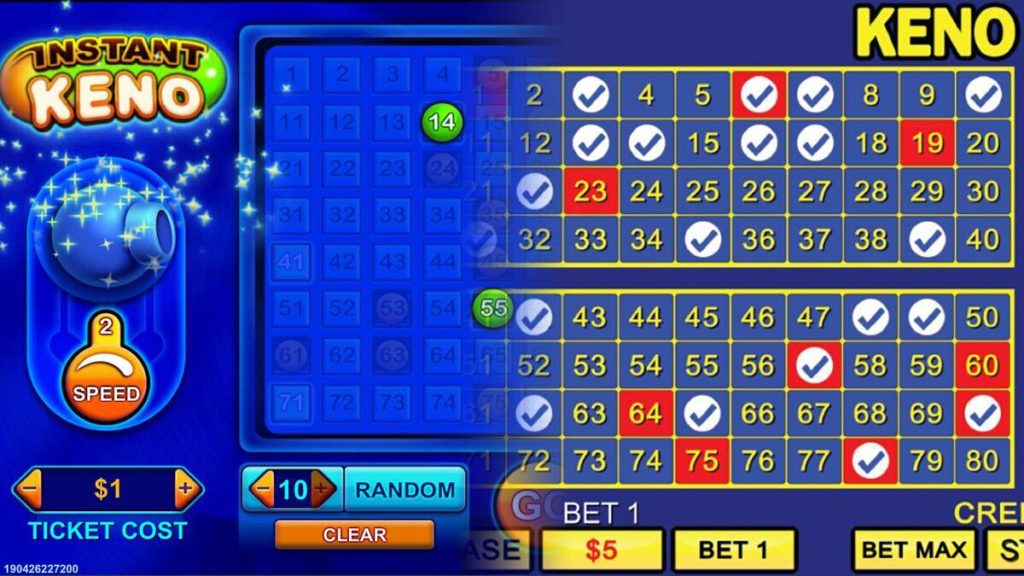Keno Numbers: The Ultimate Guide to Boosting Your Chances of Winning
Keno Numbers: Increase your odds of winning with this comprehensive guide. Understand number frequency, utilize statistical analysis, and explore effective strategies for choosing the right numbers. Take your Keno gameplay to the next level and improve your chances of hitting the jackpot.

Introduction
Keno is a popular casino game that has captured the attention of gambling enthusiasts worldwide. With its simple rules and potential for big wins, it’s no wonder that Keno continues to attract a dedicated following. However, winning at Keno is not solely based on luck; understanding Keno numbers and employing effective strategies can significantly increase your chances of success. In this comprehensive guide, we will explore the intricacies of Keno numbers and provide you with valuable insights to enhance your gameplay.
Understanding Keno Numbers
How Keno numbers are drawn
When it comes to the drawing of Keno numbers, there are several key points to understand:
- Random number generation: Keno numbers are drawn using a random number generator (RNG) algorithm. This ensures a fair and unbiased selection process, eliminating any possibility of human bias or manipulation.
- Number selection process: The Keno number selection process typically involves drawing a set of numbers from a larger pool, such as 80 numbers. The exact number of numbers drawn may vary depending on the specific Keno game variant being played.
- Mechanical draws: In some traditional Keno games, physical machines with numbered balls are used for the drawing process. These machines mix the balls thoroughly and then randomly select them one by one until the required number of balls has been drawn.
- Electronic draws: With the advancement of technology, many modern Keno games now employ electronic drawing systems. These systems use sophisticated software and RNG algorithms to generate the winning numbers. The results are displayed on screens or monitors for players to see.
- Transparency and fairness: To ensure transparency and fairness, Keno draws are often conducted in public settings or under the supervision of regulatory bodies. This allows players to witness the drawing process firsthand and ensures that the results are genuinely random.
Understanding how Keno numbers are drawn is essential for players to have confidence in the fairness of the game. Whether it’s through traditional mechanical draws or modern electronic systems, the random selection of numbers ensures an equal opportunity for all players to win.
Explanation of Keno number frequency and probability
In Keno, understanding number frequency and probability is essential for improving your overall chances of winning. Number frequency refers to how often specific numbers appear in Keno draws. By analyzing past results and tracking the frequency of certain numbers, you can identify patterns and trends.
This information can inform your number selection strategy, allowing you to focus on numbers that have a higher likelihood of being drawn. Probability, on the other hand, refers to the likelihood of a specific number being drawn in a Keno game. Each number has an equal probability of being drawn, but analyzing frequency can help you identify numbers that are “hot” or more likely to be drawn frequently.
By understanding number frequency and probability, you can make more informed decisions when selecting your Keno numbers, increasing your chances of hitting those winning combinations.
The concept of hot and cold numbers in Keno
In Keno, the concept of hot and cold numbers holds significant importance for many players. Hot numbers refer to those that have been frequently drawn in recent games, while cold numbers are the opposite, indicating numbers that have been drawn less frequently. Some players believe that hot numbers are more likely to appear in future draws, while others prefer to focus on cold numbers, anticipating that they are “due” for a win.
However, it’s crucial to note that Keno numbers are drawn randomly, and past results do not guarantee future outcomes. While tracking hot and cold numbers can be an interesting strategy, it’s essential to approach it with caution and combine it with other techniques, such as statistical analysis and personal preferences, to make well-informed number selections.
Ultimately, finding the right balance between hot and cold numbers can be a part of a comprehensive Keno strategy, but players should keep in mind that luck and chance still play significant roles in the game.
Analyzing past Keno results to identify patterns
Analyzing past Keno results is a common practice among players seeking patterns that could enhance their number selection strategy. By reviewing historical data, players can identify recurring numbers or patterns that may increase their chances of winning. Some players look for numbers that have been frequently drawn, believing they have a higher probability of being drawn again.
Others search for specific patterns, such as clusters or consecutive numbers, that have shown a tendency to appear together. However, it’s important to approach pattern analysis with caution as Keno draws are based on random number generation, and past results do not guarantee future outcomes.
While analyzing past results can provide insights and inform decision-making, it should be combined with other strategies, such as statistical analysis and personal preferences, for a well-rounded approach to selecting Keno numbers.
Strategies For Choosing Keno Numbers

When it comes to choosing Keno numbers, players often face a decision between using the Quick Pick feature or manually selecting their numbers. Each method has its own pros and cons.
Quick Pick: Pros:
- Convenience: Quick Pick instantly generates a random set of numbers, saving time and effort.
- Randomness: Quick Pick numbers are generated by a computer algorithm, ensuring a truly random selection.
- Avoiding biases: Quick Pick eliminates personal biases or superstitions that may influence manual number selection.
Cons:
- Lack of control: With Quick Pick, players relinquish control over the number selection process.
- Uniqueness: Quick Pick numbers may not be unique to each player, potentially leading to shared winnings if the numbers match.
Manual Selection: Pros:
- Personal touch: Manual selection allows players to choose numbers based on personal significance, such as birthdays or lucky numbers.
- Strategy implementation: Players can apply specific number selection strategies, such as tracking patterns or using number systems.
- Flexibility: Manual selection gives players the freedom to experiment and adapt their number choices based on their analysis or intuition.
Cons:
- Time-consuming: Manual selection requires time and effort to carefully choose and enter each number.
- Potential biases: Personal biases or superstitions may influence number selection, which might not have a real impact on the outcome.
- Decision-making pressure: Players may feel overwhelmed by the responsibility of choosing the “right” numbers, potentially leading to indecision or second-guessing.
Ultimately, the choice between Quick Pick and manual selection depends on individual preferences, playing style, and belief in personal strategies. Some players enjoy the convenience and randomness of Quick Pick, while others find satisfaction in the personal touch and strategy implementation of manual selection. It’s important to find the approach that resonates with you and aligns with your goals for a more enjoyable Keno experience.
Popular number selection strategies and their effectiveness
In the world of Keno, various number selection strategies have emerged, each claiming to improve a player’s chances of winning. While the effectiveness of these strategies is subjective and influenced by luck, here are some popular ones:
- Birthdays and Anniversaries: Many players choose numbers based on significant dates, such as birthdays or anniversaries. While this strategy adds personal meaning to the numbers, it’s important to note that it relies on a limited range of numbers (1-31) and may not consider other factors affecting Keno outcomes.
- Lucky Numbers and Superstitions: Some players have specific lucky numbers or superstitious beliefs that guide their number selection. These can range from favorite numbers to numbers associated with personal experiences or cultural beliefs. While purely based on personal belief, these numbers hold sentimental value and can add excitement to the gameplay.
- Random Number Generation: Random number generation techniques, such as using random number generators or drawing numbers from a hat, offer an unbiased approach to number selection. This strategy removes personal biases and superstitions, relying solely on chance.
- Analysis of Historical Data: Some players analyze past Keno results to identify patterns, hot or cold numbers, or number clusters. By studying historical data, players attempt to make informed choices based on the frequency of number appearances. However, it’s important to remember that Keno draws are random, and past results may not predict future outcomes accurately.
- Number System Strategies: Number systems involve assigning values or patterns to numbers and using them to create combinations. These systems can range from simple to complex, aiming to enhance number selection based on specific rules or formulas. Players may create their own systems or follow established ones.
The effectiveness of these strategies is subjective and depends on personal preference and luck. While strategies can add structure and excitement to gameplay, Keno remains a game of chance, and no strategy can guarantee a win. It’s important to approach number selection with a balance of rationality, enjoyment, and responsible gambling practices. Experiment with different strategies and find the one that resonates with you, keeping in mind that luck ultimately plays a significant role in Keno outcomes.
Utilizing Statistical Analysis for Keno Numbers
Introduction to statistical analysis tools for Keno
Statistical analysis tools have become valuable assets for Keno players seeking an edge in their number selection and gameplay. These tools provide a systematic approach to studying past results, identifying patterns, and making data-driven decisions. By leveraging statistical analysis, players can gain insights into number frequency, distribution, and clusters, ultimately aiding in strategic decision-making.
These tools can help players analyze large amounts of data efficiently and provide visual representations, such as graphs and charts, for a clearer understanding of patterns and trends. From tracking hot and cold numbers to detecting number correlations, statistical analysis tools offer a scientific and methodical approach to Keno.
By utilizing these tools, players can make more informed choices, refine their strategies, and increase their overall chances of winning. Whether through specialized software or online resources, incorporating statistical analysis tools into Keno gameplay can significantly enhance the player’s understanding of the game and improve their overall outcomes.
Analyzing number frequency and distribution
Analyzing number frequency and distribution is a fundamental aspect of statistical analysis in Keno. By studying how often specific numbers appear in past Keno draws, players can gain insights into the likelihood of certain numbers being drawn in the future. Frequency analysis involves tracking the occurrences of individual numbers over a given period and identifying which numbers have a higher or lower frequency of appearance. This analysis helps players identify hot numbers (frequently drawn) and cold numbers (infrequently drawn).
Distribution analysis focuses on the overall pattern of numbers in Keno results. It examines how numbers are spread across different ranges or positions, such as low numbers (1-40) or high numbers (41-80), or by positional groups like the first ten numbers, second ten numbers, and so on. By understanding the distribution of numbers, players can identify patterns, clusters, or gaps that may influence their number selection strategy.
Both frequency and distribution analysis provide valuable insights into the behavior of Keno numbers. However, it’s important to note that Keno draws are random, and past results do not guarantee future outcomes. Analyzing number frequency and distribution should be used as a tool to inform decision-making, rather than as a definitive predictor of winning numbers. By combining these analyses with other strategies and personal preferences, players can make more informed choices and potentially increase their chances of selecting winning numbers in Keno.
The Role of Keno Number Systems
Overview of Keno number systems and their purpose
Keno number systems are structured approaches to selecting numbers in the game, aiming to increase a player’s chances of winning. These systems involve assigning values, patterns, or rules to numbers and utilizing them to create number combinations. Here’s an overview of some common Keno number systems and their purposes:
- Straight Number Systems: Straight number systems assign a specific value to each number and focus on creating straight lines or patterns on the Keno ticket. For example, a player may choose numbers that form a straight line vertically, horizontally, or diagonally. These systems provide a visual structure for number selection and can be useful for players who prefer a systematic approach.
- Balanced Systems: Balanced systems aim to distribute numbers evenly across the Keno ticket. They involve selecting numbers from different ranges or positional groups to ensure a balanced representation. This strategy prevents over-reliance on specific number ranges and increases the chances of hitting numbers from various parts of the ticket.
- Combination Systems: Combination systems involve creating multiple combinations of numbers based on specific rules or patterns. For instance, a player might select a group of numbers and combine them in different ways to cover various possibilities. This approach increases the coverage of numbers and enhances the probability of hitting winning combinations.
- Reduced Systems: Reduced systems focus on reducing the number of combinations played while still maintaining a high coverage of numbers. These systems employ mathematical algorithms to optimize the selection process, reducing the total number of tickets needed to cover a specific set of numbers. By minimizing the number of tickets played, players can save on costs while maintaining a reasonable chance of winning.
The purpose of Keno number systems is to provide players with a structured and strategic approach to number selection. These systems offer a way to organize numbers, increase coverage, and potentially improve the odds of winning. However, it’s important to remember that Keno remains a game of chance, and no system can guarantee consistent wins. Players should use number systems as tools to enhance their gameplay and combine them with other strategies, statistical analysis, and personal preferences for a well-rounded approach to playing Keno.
Popular Keno number system examples
There are several popular Keno number systems that players employ to enhance their number selection strategy. Let’s discuss a few examples:
- The 2/4 System: This system focuses on selecting two groups of four numbers each. Players choose four numbers from the lower range (e.g., 1-40) and four numbers from the higher range (e.g., 41-80). The purpose is to cover a wider range of numbers and increase the chances of hitting winning combinations across the ticket.
- The 3/6 System: Similar to the 2/4 system, the 3/6 system involves selecting three groups of six numbers each. Players choose six numbers from the lower range, six numbers from the middle range, and six numbers from the higher range. This system aims to provide even more coverage across the Keno ticket and increase the probability of hitting winning numbers.
- The Cluster System: The cluster system involves selecting groups of adjacent or neighboring numbers on the Keno ticket. Players may choose clusters of two or more numbers that are physically close to each other. This system is based on the belief that numbers in close proximity may have a higher chance of appearing together in a draw.
- The Birthday System: This system relies on selecting numbers based on birthdays or significant dates. Players choose numbers that correspond to the day, month, or year of important events. While this system holds personal meaning, it should be noted that it limits the number selection to a specific range (e.g., 1-31) and may not provide optimal coverage across the ticket.
- The Wheel System: The wheel system involves selecting a core set of numbers and combining them with various additional numbers to create multiple tickets. This system aims to cover more combinations while keeping the cost manageable. By leveraging mathematical algorithms, players can optimize their number selection and increase their chances of hitting winning combinations.
It’s important to remember that the effectiveness of these number systems is subjective and influenced by luck. While some players find success using these systems, others may not experience the same level of consistency in winning. Each system offers a unique approach to number selection, and players should choose the one that resonates with their playing style and preferences. It’s also advisable to combine number systems with other strategies, statistical analysis, and personal intuition for a well-rounded approach to playing Keno.
Tips for Maximizing Your Keno Number Selection
Maximizing your Keno number selection requires a thoughtful approach and consideration of various factors. Here are some tips to enhance your chances of success:
- Understand the Game: Familiarize yourself with the rules, payout structure, and odds of Keno. This knowledge will help you make informed decisions and set realistic expectations.
- Analyze Past Results: Study historical data and analyze number frequency, distribution, and patterns. While past results don’t guarantee future outcomes, they can provide insights into the behavior of Keno numbers and guide your number selection strategy.
- Utilize Statistical Tools: Leverage statistical analysis tools, software, or online resources to facilitate the analysis of number frequency, hot and cold numbers, and other statistical patterns. These tools can help you make data-driven decisions and identify trends that may influence your number selection.
- Diversify Your Number Selection: Avoid relying solely on personal biases or superstitions. Instead, create a balanced number selection by incorporating a mix of high and low numbers, even and odd numbers, and numbers from different positional groups. This approach increases your coverage and reduces the risk of missing out on potential winning combinations.
- Consider Number Systems: Explore different number systems, such as straight systems, balanced systems, or reduced systems, to add structure and strategy to your number selection. These systems can optimize your coverage and provide a systematic approach to choosing numbers.
- Manage Your Bankroll: Set a budget and stick to it. Keno is a game of chance, and it’s essential to gamble responsibly. Avoid chasing losses or increasing your bets beyond what you can comfortably afford.
- Play with Reasonable Expectations: Remember that Keno is a game of luck, and winning is not guaranteed. Approach the game with a positive mindset and enjoy the experience, rather than solely focusing on the outcome.
- Practice and Experiment: Use free online Keno games or low-stakes games to practice different strategies and test your number selection techniques. This will allow you to refine your approach without risking significant amounts of money.
By incorporating these tips into your Keno gameplay, you can maximize your number selection and increase your chances of achieving favorable outcomes. Remember to adapt your strategies based on your own preferences and experiences, and always gamble responsibly.
Conclusion
In conclusion, understanding the world of Keno numbers is a crucial aspect of playing the game strategically and increasing your chances of success. Whether you prefer manual selection or rely on Quick Pick, considering the concept of hot and cold numbers, analyzing past results, or utilizing statistical analysis tools, each approach adds layers of depth to your number selection strategy.
Exploring popular number systems and implementing effective tips such as diversifying your number selection, managing your bankroll, and playing with reasonable expectations can further enhance your gameplay. It’s important to remember that while these strategies and approaches can provide insights and structure, Keno ultimately remains a game of chance. Luck plays a significant role, and there are no guarantees of consistent wins.
Enjoy the excitement and thrill of the game, and always gamble responsibly. Whether you’re a Keno enthusiast or a newcomer to the game, may these insights empower you to make more informed decisions when it comes to selecting your Keno numbers and heighten your overall enjoyment of this captivating game of chance.
Frequently Asked Questions
Q1: Are there any specific numbers that have a higher chance of appearing in Keno?
A1: No, Keno draws are random, and each number has an equal probability of being drawn. While analyzing past results can provide insights into number frequency, it’s important to remember that Keno is a game of chance, and no number is inherently more likely to appear than others.
Q2: Should I use Quick Pick or manually select my Keno numbers?
A2: The choice between Quick Pick and manual selection ultimately depends on personal preference. Quick Pick offers convenience and ensures random number generation, while manual selection allows for personalization and the application of number selection strategies. Consider your playing style and whether you value control or prefer a more randomized approach.
Q3: Can analyzing past Keno results predict future outcomes accurately?
A3: Analyzing past Keno results can provide valuable insights into number frequency and patterns, but it cannot guarantee accurate predictions. Keno draws are random, and each draw is independent of previous results. Treat historical data analysis as a tool to inform your decisions, but always remember that luck plays a significant role in the game.
Q4: Do number systems guarantee success in Keno?
A4: No number system can guarantee consistent wins in Keno. Number systems offer structured approaches to number selection and may enhance your coverage or strategy, but they cannot overcome the inherent randomness of the game. Use number systems as a tool to guide your decision-making, but always approach the game with realistic expectations and a focus on enjoyment rather than solely chasing wins.




